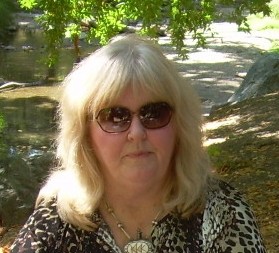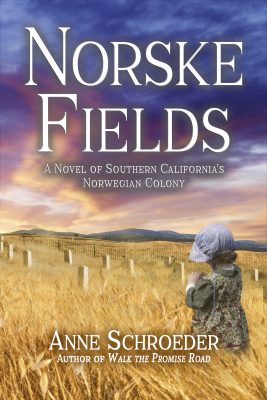Norske Fields: A Norwegian Colony
“Write what should not be forgotten.”
—Isabel Allende
I’m excited to have my good friend Anne Schroder and her new novel with us today. Welcome, Anne!
Norske Fields is a family saga about the young bachelors and their sweethearts who settled in the Norwegian Colony of Southern California. Anne’s here to talk with us about her research and her new historical novel. So let’s get started!
Was it hard to create an emotional, true-life story?
Harder than it might seem to write about your own ancestor’s day-to-day lives, squabbles, deaths and disappointments. These were my people. I recalled stories from my childhood about my great-grandfather and other Norwegians blasting a steep grade out of solid rock so they could get their crops to market. Grandsons and granddaughters had created chronologies and timelines so I begged, borrowed and pleaded for information. The romantic drama took fifteen months to craft into something that would allow readers to live in the story.
What writing challenges presented themselves? Any insights you had while writing?
One of the first challenges was deciding whose story I was telling. Who would be my POV characters? Five bachelors from the same region had to have distinct voices and personalities. I began the story with my great-grandfather in his church in Stranda, Norway, trying to woo a pretty girl. But if she marries him she must leave her family for an unknown land. Then I introduce his bachelor friends. We see what they are leaving behind as well—no easy choices. A “Cast of Characters” keeps everything sorted out. The language, foods and attitudes seemed familiar to me, a sort of second language that I had learned from being around my grandparents. Some examples were the cold pancakes spread with jelly, cottage cheese and rice with milk and sugar. These were American versions of lefse and soft cheese—comfort foods that I never associated with Norway until I started thinking about it. Not to mention cake with whipped cream and strawberries!
I wrote through the entire Covid shutdown, with tears of gratitude for the sacrifices my great-grandparents made when they came to America. I want this story to be bigger than a family saga. I want it to stand on its own as an award-winning novel that readers will enjoy.
Norske Fields has been called heartrending. What sparked the story for you?
As a young woman I saw a photograph of my grandfather, Oscar Olsen, watching county workers exhume the coffins of his six young sisters and brother from an old family cemetery at the corner of Moorpark and Olsen Roads. Grandpa’s eyes held unfathomable pain of a brother remembering his long-ago childhood. I wanted to know those little girls and boy. I wanted to connect with my heritage.
What made the Norwegian Colony so memorable?
The story grew from thousands of facts known about the residents of the Norwegian Colony and the land that was later developed as California Lutheran University, in Thousand Oaks, California. The land was originally part of Jose de la Guerra’s Spanish land grant. It held brief interest for oil speculators, lying as an untilled section of property nestled against rolling hills. Then in 1890, Norwegians put a plowshare to the hard-packed clay soil. Their efforts resulted in mutual support and a community of friends as they adapted to dryland farming that was strange and challenging to newcomers. The Norwegians endured tribulation, but their joy and satisfaction with their new homes was well recorded in diaries and letters home. They laughed, sang, played and celebrated life within their little colony.
The cover has a cute little girl standing in a cemetery. What’s the story behind this?
The gravestones are those of the people who died in the Colony. I began with a sheet of paper with a thick black border entitled: “Those buried in the Olsen Cemetery and moved to Ivy Lawn Cemetery in 1957.” From this list of names, birthdates, deaths I constructed the struggles of new immigrants in a foreign land. Some of the dialogue came from stories passed down to grandchildren now in their eighties, who recalled attitudes, personalities and actual quotations. For the rest, well, that is for the reader to decide.
What’s the take-away for you?
I’m hearing from descendents of the five immigrant families and even unrelated readers who tell me they are reading the story at a snail’s pace, dwelling in the story, absorbing every line. Others have finished it and say they felt like they actually lived in the Colony. For me this is how books should be written—and read. The story should stay with you long afterward.
Order your copy of Norske Fields



Ann, it would be my pleasure.
Thank you, Julie. And I in turn learned from Jane Kirkpatrick. It’s always amazing how much information one needs to write an authentic story.
Anne and Carmen, This was a fascinating blog. As I lived in Seattle a long time, I was familiar with how many “Norske” residents we had there. I thought your comments about how you did research and decisions you made in writing this book were also helpful. Thank you both!
Julie, I agree. Anne was brilliant with this book. I’m reading it now. Loving every page. Her research was remarkable. We can all learn from Anne.
Norske Fields sounds like a must-read. My husband worked for many years for a Norwegian company and I met many of the people he worked with when hey visited from Norway. This sounds like a book that would satisfy that interest.
Mary, that is fascinating. I ordered my copy last night and read the first chapter before lights out. So far I love it!
Mary, I would love for you to review my book. Your teviews ate thoughtful and balanced. I intended to bring the Norske womes’s spirit to the plain story of toil and hope.